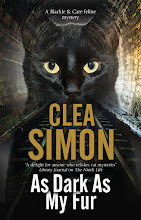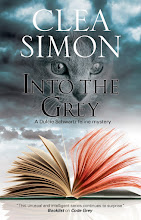
Hi, everyone! Hope your holidays have brought you all the treats you desire (like this basketball-playing kitty) and no lumps of coal. As we wait for 2008 to come 'round, I thought I'd cheat a little and re-post something not quite new.
A version of this ran on Linda L. Richards' blog , where it sparked quite a few comments. Most of them were supportive; the few that weren't seemed to think I was apologizing for what I write. I'm not, and therefore I've revised my "Defense" to reflect that. At the risk of being redundant, I re-post here, with many thanks to commentators like Roberta Isleib (who pointed out the money differential), Elaine Flinn (who has famously noted, "What is cozy about murder?"), and most of all to Linda for the original space. (And look for Linda to be guestblogging here, as well, in January when her own hotly anticipated fourth crime novel (Death was the Other Woman ) comes out.
So let me start again. What is a cozy? I confess that I was thrilled when the website blurb posted by Partners and Crime, called my new mystery, Cries and Whiskers “cat-friendly tough-girl crime fiction.” I mean, it's true that I always make a point of telling people that my books aren’t cutesy, my cats don’t talk, and they don’t solve the crimes. Punny titles and cute cat covers aside, I’m not one of those people who refers to her pets as her “furbabies.”
But it’s time to give up the pretence and come clean. Hi, I’m Clea Simon, and I write cozies. Classic Cozies. My books feature an amateur sleuth (a rock critic, rather than a nosy old lady). They take place in a small self-contained community (the club scene, rather than an English village). The crimes involved tend to come about because of human nature, not psychopathology, and the sex and violence are pretty much out of sight (I rather like the description that “the blood is dry before it hits the page”). And while some of us may be using the label “traditional” to distinguish ourselves from the treacly side of the genre, I’m ready to stand up and admit it. Hell, I’m sick of apologizing. I want to reclaim the cozy.
Yes, cozies have fallen out of critical favor. They are now looked down upon as vaguely embarrassing. Nursery lit. Some of it is our own damned fault: a trend in the subgenre toward humor, crafts, and cutesiness has helped bring down our reputation. Some of it, I deeply suspect, is sexism. Cozies are largely written by and read by women. They're gentler. Therefore (and this follows a long tradition that ranges from arts coverage in newspapers to pay equity in "pink collar" jobs) they are considered of lesser value.
Because even when we aren’t self-destructively winsome, even when we are at our best, we still tend to lose out – in review space, in serious consideration, in awards, in size of advances, press runs, and more – to harder-boiled crime fiction. In part, that's because hard-boiled and noir tend to push our buttons a little more, tend to push our boundaries. Transgressive styles of art have always attracted more attention from critics and from those outside any field. They are what’s new, what is edgy. What is, in some form, outrageous.
I have nothing against transgressive art. Not that long ago, I found my soul in punk rock. The energy of the music - not just anger, but a pure, visceral cry - gave voice to my own inchoate emotions. I believe it literally saved my sanity, giving me a means of expressing that which had been choking me. I will never deny what this music, what this art form, did for me, and I reject, as well, the idea that this music - or any art - is of a particular stage or age. Don’t give me your adolescent angst; emotion is eternal.
But so is the best writing. That’s why I believe a stylist with the skill of a Linda Richards or a Megan Abbott will continue to be read. Denise Mina, too, and doubtless many others.
Along the same lines, and for the same reasons, so will the best of the traditional mystery authors – the cozy writers. Just like those other writers, we write from our hearts – but our hearts, or at least our palates, are differently inclined. We’re the ones who focus on character development, rather than action or atmosphere, writing about people we know rather than the ones we dream – or have nightmares – about. We’re the ones who go for subtlety over shock value, for the human resolution over the bloody denouement. For a bit of humor, maybe even a bit of romance. You know, the stuff of real life. We don’t hit you over the head with our craft, and these days particularly, we don’t get the credit for what we can – and reliably do – provide. It’s a different palette, sure, like working in watercolors in an age of high-gloss graphics, but I think it’s time to quit apologizing for that difference. To quit ducking the label, or qualifying it as "not-quite-cozy" or "quirky cozy," both of which I confess to using. No, it is time to reclaim our own genre.
So here goes. I write traditional mysteries, with characters I want you to believe in, with settings you’ll recognize and motives you may share. Guess what? I write cozies.
See you all – with fresh posts – in the New Year!


















